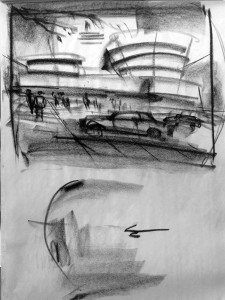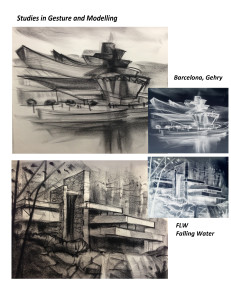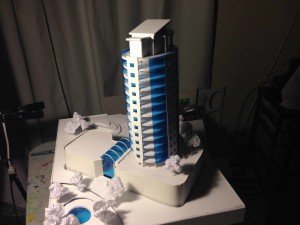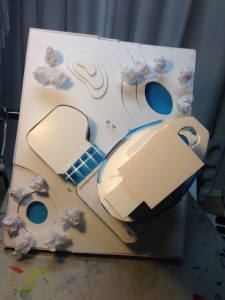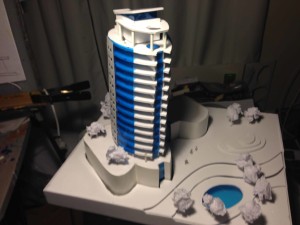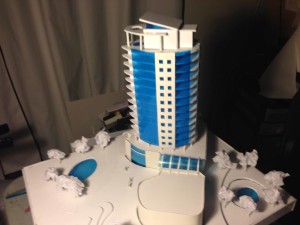This is pretty much the backbone of my own artistic learning, practicing, and teaching methods, as regards drawing. Of course, it also works into painting, design, etc:
Think of drawing as being comprised of 10 distinct perceptual filters, abilities, or ways of seeing. (Long ago I read a very famous book called “Zen of Seeing, Drawing” by F.Franck – Definitely worth reading – lots of great and valid insights! Franck’s book started me thinking in this direction). Like the filters a photographer might use with a camera, we can use these ways of seeing individually or in combinations on a single drawing to achieve a near-infinite variety of effects. When you have mastered them, even at a basic level, you will have a powerful “tool kit” for use in drawing, painting, and design of all kinds. The following are basically a set of preliminary studies, aimed at creating a very thorough awareness in the artist. The trick is to keep the energy going from prelims through the final drawing. With experience you can do a lot of it in your head, flipping from ‘filter’ to ‘filter’, mentally. Perspective used alone can deaden the overall image. Here, the 10 Ways are illustrated primarily using Frank Lloyd Wrights MOMA Guggenheim.
1- GESTURE: Imagine the way a ‘mime’ might make gestures in the air to describe your subject. You pretty much do the same thing but leave a record on paper with charcoal when describing, for example, a vase of flowers or a building. This involves larger arm muscle movement – air guitar with charcoal. Gestures are considered the ‘lines of life’. If there is a strong gesture there is greater chance of having life and power in your drawing. Everyone can do it, but practice makes it into a skill. All the drawings that follow begin with a light gesture underneath. Below are gestures of FLW’s Guggenheim in NY and of Gehry’s Guggenheim in Barcelona –
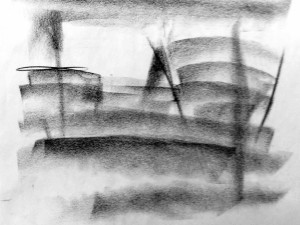
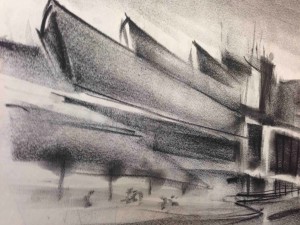
2-CONTOUR: Draw the edge-lines in a subject with enhanced tactile content by developing the strong belief that you are ‘touching’ the object with finger tips or flats. This belief is transmitted into the marks and out to the viewer. Edges (finger tips) become lines; surfaces (finger flats) become textures. Develop ‘line-quality’, for example, by digging in at the beginning and end of each line. Corners, intersections , places where lines stop and change directions are made important –
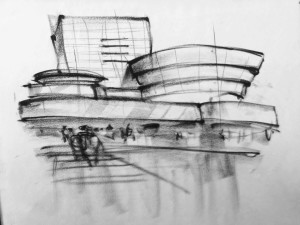
3- MASS: The 3d volumetric ‘heft’ of a subject – like a wireframe but with more feeling of the weight of the object and its parts –
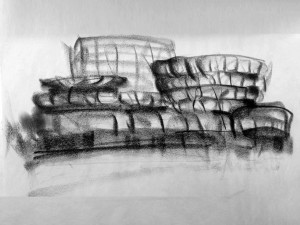
4- SPACE: Space must be thought of as an actual, tangible, moldable substance, not merely the absence of form. Think of a subject immersed in water. Draw the water, encountering the subject and pausing the medium where it stops against the subject. The sum total of stoppages implies the form. But don’t draw the actual form…concentrate on the space(s) and that will gradually reveal the form. This is, perhaps, the most difficult ‘way of seeing’ to master, but there is much to gain from it. The water metaphor helps –
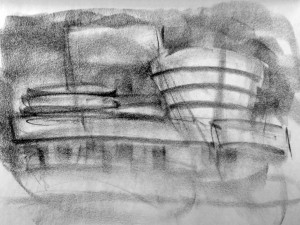
5- SILHOUETTE: The positive silhouette is like the shadow of a subject projected on a wall. The negative silhouette is the reverse. Concentrate on ‘shape-making…don’t just draw and colour in the outlines –
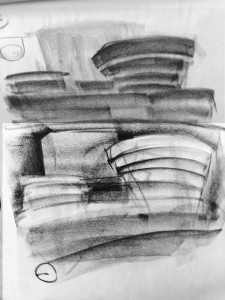
6-FIGURE-GROUND: A shape or object has 3 ways to contrast with the background: darker than, lighter than or transitional (part darker and part lighter). The ‘transitional’ is also called a “figure-ground reversal”. You take control and choose –
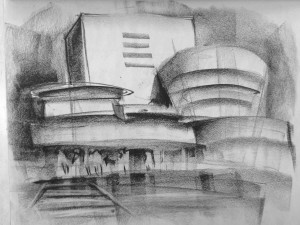
7-STEPPED TONALITY: Translate a continuous toned image into 3 or 4 tonal values: The lights give Sparkle. The darks give impact. The mid-tones give subtlety and richness. Pay particular attention to the ‘dance of the lights’. This creates a ‘tonal design’ versus a mere ‘documentation’ –
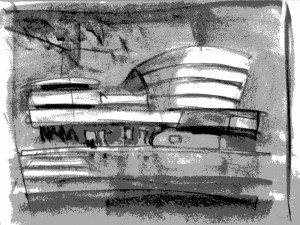
8- MODELING: Select a light source and logically create shade sides and cast shadows. This is what we normally try to do when shading naturalistically –
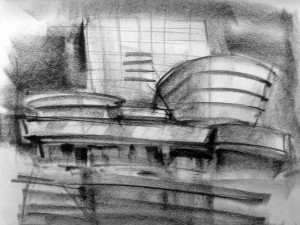
9- GEOMETRICS (Perspectives, paralines, proportion) Apply the methods of geometry to creating the 3d visual illusion. The three main visual cues for depth are: overlapping, diminution, convergence. These are supported by ‘position on a background plane’, atmospherics, lineweights, colour temperature, degree of detail and sharpness of focus, etc –
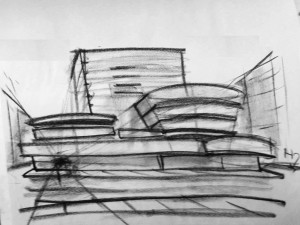
10- COMPOSITION: Composition is ‘what you do with all the other ways of seeing’. You have to go after composition as a special skill in itself. Don’t just rely on getting better at it by drawing a lot – that is a very slow way to progress. In music you can get very good at playing the instrument but never develop the ability to compose. In music, people go after composition for it’s own sake – so it goes with art. Apply an ordering concept, a design, to the elements in the picture. There are many traditional systems, or you may create one of your own through observation or informed intuition. You are creating a simple, clear choreography for the eye of the viewer. This is the ‘design concept’ we apply to the organization of the pictorial image. Also consider scale, format, cropping, focal points, eyepath, dominance, balance, numbers and hierarchy of shapes, and other general design principles. Consider foreground, midground background. Dark areas have light things in them, light areas have dark things in them. Can you have a transition in figure-ground somewhere? I deal with composition in more depth elsewhere among my blog entries –
